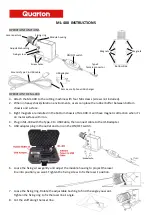
miniDSP Ltd, Hong Kong /
/ Features and specifications subject to change without prior notice
19
3.4
M
ORE ON
IEM
MEASUREMENTS
Figure 8 shows the effect of different eartips (each graph is the average of left and right on an Etymotic ER4SR).
While EARS can be used to measure the frequency response changes that you hear with different eartips, this
also means that the eartips you used should be mentioned if sharing or publishing your measurements.
Insertion depth also makes a big difference. Figure 9 shows measurements at three insertion depths (ER4SR with
Comply foam isolation tip). It is important to note that not only does the level change with insertion depth, but
so does the frequency response.
Because of this, when measuring IEMs that don’t have a fixed insertion depth, w
e recommend that you repeat
the reference SPL level check on each insertion and for both sides
–
that is, don’t change the headphone amp
volume, just check the level and move the IEM out or in a little until the level is close to your reference level.
Additional notes and things to be aware of when measuring IEMs:
•
IEM measurements vary quite a lot at high frequencies, and generally drop off very quickly at 15 kHz or so.
Be careful when doing high frequency EQ and don’t try and EQ up the frequency response ab
ove 15 kHz.
•
It’s possible with some IEMs to inadvertently obstruct the end of the IEM tube. This will show up as greatly
reduced bass response.
•
Some IEMs will show strong resonant peaks in the response. Sometimes these are the IEM itself, but other
times i
t’s a resonance in the “ear canal” that moves around with insertion depth
.
Don’t EQ the latter.
•
Avoid inserting a “deep insertion” IEM in as far as it will go, as the tip will collide with the microphone
capsule. This will obstruct the tube and produce a poor measurement. It could also (if done forcibly)
potentially damage the capsule.
Figure 8. Effect of different IEM eartips
Figure 9. Effect of IEM insertion depth






































